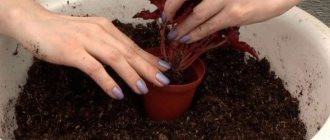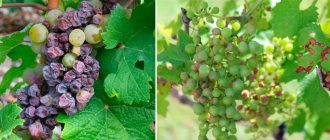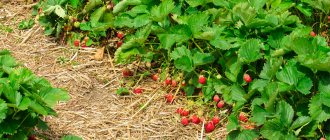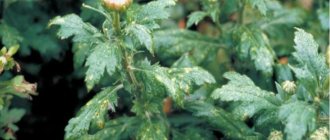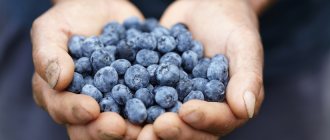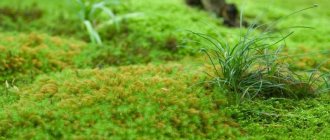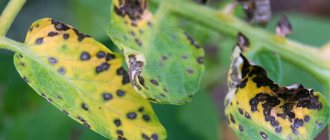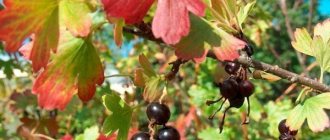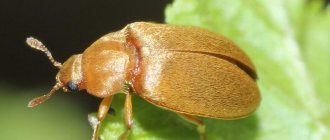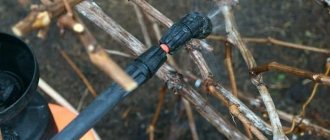How to detect and defeat blueberry diseases
Among blueberry diseases, the most common are those caused by fungal pathogens. They affect roots, stems or leaves.
These pathologies are often called various rots or spots: the proliferation of the fungus is accompanied by the appearance of spots on the green parts of plants, and in the future can even lead to their death. All diseases are similar to each other, but they can be distinguished by certain manifestations.
Many fungal diseases manifest themselves with typical symptoms. If it is not possible to differentiate them, it is enough to treat them with a broad-spectrum fungicide.
Stem cancer
Phomopsis (Phomopsis drying out of branches, infection with the Phomophsis fungus) is an equally common disease. Young shoots dry out at the tops and curl, and the bark becomes covered first with small reddish and then large brown spots.
Infection begins at the tops, but then spreads to the entire plant. Fungicides such as Topsin, Skor, Tridex and their analogues are effective against Phomopsis.
Gray rot
Fruit moniliosis occurs not only on berries. At first, the fruits develop normally, but then quickly dry out. The leaves and shoots of bushes are covered with a coating that resembles frost.
The pathogen remains to overwinter in the berries. The only method of control is to remove the affected shoots; it is also useful to treat blueberries with urea.
Physalosporosis
White spotting (septriosis) - its manifestations can be confused with symptoms of other fungal diseases. The spots are initially small, light brown in color, with a purple edge. Then they become large, completely purple. Disease control includes preventive and emergency treatments with systemic fungicides.
Witch's broom
Another reason why blueberries do not bloom or bear fruit, and the bushes wither, is a viral infection. It spreads as quickly as fungal pathogens, completely covering the entire planting.
Among the most common viral diseases are the following:
- mycoplasmosis (dwarfism) - manifested by a decrease in yield and rapid drying of leaves; in early autumn they begin to quickly turn red;
- filamentous branches - with this disease, leaves wrinkle, and stripes resembling threads appear on young shoots;
- mosaic - yellow streaks appear on the leaves, but the tips remain green;
- red ring spot - red ring-shaped spots appear first on old leaves, and then on the entire bush.
Viral diseases are more dangerous for blueberries. It is almost impossible to destroy the pathogen, so all measures are aimed at preventing infection of other plants. The bushes must be carefully removed by the roots and burned.
Pests and their control
In addition to viral and fungal infections, pests can significantly reduce yields and lead to plant death. The most common are:
- a caterpillar that lives on the leaves of a plant;
- aphids infect the upper parts of the plant and are carriers of viral diseases;
- the leaf roller eats leaves and buds, enveloping the tops with cobwebs;
- The flower beetle damages the buds as well as the buds;
- the kidney mite “injures” the kidneys, leading to their looseness;
- Khrushchev eats away the color and eats the leaves.
To eliminate such an unpleasant neighborhood, you need to carry out spring spraying. Both chemical and organic preparations can resist pests. Before the buds open, you should treat with Azofos, during the period of active leaf growth - with Skor, during fruit set - with Tercel, and during fruiting, Skor will come to the rescue again.
Important! Remember that the use of aspen sawdust (mulching) introduces an additional dose of nitrogen into the soil. Exceeding the level of this element in the soil will have a negative impact on the crop.
The most effective fungicides are:
- "Mission";
- "Allergo";
- "Serenade";
- "Topaz".
Traditional recipes are often used as preventive measures. Some are very effective, but not against pests and diseases. They can be completely eliminated only with the help of chemicals.
Micronutrient deficiency
The health of blueberries is also affected by the amount of nutrients in the soil. Plants may suffer from hypovitaminosis, a decrease in the amount of micro- and macroelements. When they appear, it is enough to replenish the level of the deficient substance, and the condition of the bushes will gradually return to normal.
Such diseases can manifest themselves with characteristic symptoms:
- lack of nitrogen is the reason for the appearance of yellow leaves in blueberries with a red tint;
- phosphorus - the leaves become bright red and begin to grow parallel to the shoots;
- calcium - a yellow edging appears on the leaves;
- potassium - the tops of leaves and branches gradually turn black and fall off;
- magnesium - the tips of the leaves become red;
- boron - the leaves turn blue and practically do not grow;
- gland - yellow leaves with bright green streaks;
- sulfur - blanching of the green parts of plants.
Blueberries, like most cultivated plants, require preventive treatments with pesticides, fungicides, as well as regular fertilization. In such conditions, the bushes grow large and bear fruit well.
It is worth remembering that a low level of productivity in young plants is normal if it is not accompanied by signs of fungal diseases or the appearance of pests. A good harvest can only be obtained from those bushes that have reached 5-6 years of age.
Preventive methods
To avoid pests you need to do the following:
- When choosing a blueberry variety, you need to buy disease-resistant plants and local varieties;
- When planting blueberries, the soil must be acidic, fertilized with mineral additives; it must be watered, because the plant loves moisture. For blueberry seedlings, choose sunny places, far from weeds. Bushes are planted at least 2 meters apart;
- All damaged areas of the plant should be removed immediately. Do not skimp on regular inspections of blueberries; trim them on time so that there is constant air circulation;
- In early spring and late autumn, treat blueberries with Bordeaux mixture;
- After complete leaf fall, all fallen leaves should be burned. Do not leave leaves under the bush for the winter, because... pathogenic microorganisms can live in them;
- You can treat blueberries after harvest with fungicides.
Prevention measures also include mulching and inter-row disking. You can use sawdust and spruce branches as mulch, which are laid at least 5 cm thick.
Blueberry diseases and how to treat them
In the process of intensively growing blueberries, gardeners are faced with diseases that lead to changes in color, structure, drying out of individual organs or death of the entire bush. Information about the types, signs of diseases, and methods of fighting infections helps to avoid mistakes in crop care.
Fungal diseases
The introduction and development of all types of fungi are characterized by the same prerequisites:
- large volume of precipitation;
- sustainable warmth;
- proximity to groundwater;
- lack of drainage;
- dense plantings;
- mechanical damage to the stem, shoots, leaves;
- unsuitable acid-base environment of the soil, unbalanced mineral supplements.
Fungi are visualized on damaged surfaces as a sticky substance or mold with fluff. Infection occurs through neighboring diseased plants, spores are carried by insects, wind, and precipitation. Infectious agents overwinter on blueberry bushes, in fallen berries, and on the ground.
Classification of blueberry diseases
At the moment, there is no official classification of blueberry diseases as such. However, for convenience, many gardeners divide all known ailments characteristic of this plant into two conditional groups:
- fungal;
- viral.
Fungal diseases, as the name suggests, are caused by fungal organisms. Most often, they develop as a result of violations of blueberry growing conditions, for example, due to improper watering or a poorly selected planting site.
Viral diseases are spread by various viral vectors. These include both various pests and harmless insects that were near the injured blueberry bush. Through a cut or break, the virus enters the plant cells and, if the crop has weak immunity, begins to actively multiply, which leads to the development of disease in blueberries.
But, regardless of the type of disease, at the first unfavorable symptoms you should immediately begin the treatment process, because due to delay you can lose not only the seasonal blueberry harvest, but also the entire bush. Below we consider in more detail the types of blueberry diseases and methods of their treatment.
Prevention measures
To prevent the development of fungal and viral infections, disease-resistant blueberry varieties are selected. Proper soil preparation and crop care reduces the risk of diseases and pest attacks.
Preventive measures include:
- control of soil acidity, adding organic acids to the soil if necessary;
- planting blueberries in a loose, drained substrate;
- avoiding waterlogging of the soil;
- autumn and spring pruning of diseased and deformed blueberry shoots;
- weeding;
- balance of applied fertilizers;
- mulching the soil around plants and between rows with bark or sawdust;
- covering blueberry bushes with spruce branches for the winter to repel rodents;
- the use of covering material to prevent freezing and weakening of the crop;
- treatment of plants with fungicides in early spring, three times after the leaves appear at intervals of a week, 3 times after harvesting the fruits and at the end of the growing season;
- sanitary cleaning of the land from fallen leaves, berries, and fragments of branches.
Before planting blueberries, the intended area is checked for the presence of beetles and wireworms. If the concentration of insects per 1 sq. m exceeds 2 and 7 individuals, respectively, then such a place is not suitable for blueberries.
Garden blueberries are highly resistant to external factors. It is unpretentious and resilient; agricultural cultivation technology is aimed at enhancing growth and fruiting.
If proper care and planting requirements are not followed, the plant can become infected with dangerous diseases. The likelihood of infection is observed in dry and warm summers, against the backdrop of a protracted spring with severe frosts. Diseases can lead not only to crop loss, but also to the death of the bush. In this article I will tell you how to deal with pigeon diseases and avoid them in the future.
Blueberry - a bush of health
The plant grows up to 120 cm upward. The bush is very branched, with brownish, dark gray bark, young branches are green. The stem is erect, cylindrical, rounded. The leaves are small, on short stalks. The fruit is a pear-like oval-shaped berry, blue in color with a bluish bloom. Blueberry productivity can reach 550 kg per hectare or 100 kg per bush, but only subject to proper planting, care and acidic soil. Blueberries, despite their frost resistance, are very sensitive to late spring frosts and precipitation. Bees play a very important role, if not a decisive one, in the life of blueberries. They pollinate flowers and with their help 67% of the ovary is formed. Without bees, this figure is catastrophically small and amounts to 5.6%!
Blueberries are harvested by hand. Fresh fruits are stored for several days. Improvement in blueberry yield is affected by rejuvenation of branches, which is recommended to be carried out once every 3-4 years in autumn or early spring. The berries can be dried at a temperature of 40-55 degrees in special ovens or electric dryers.
Let's also talk about blueberry diseases, their manifestations and methods of control. Let's start with a fairly common problem for all novice gardeners.
Fungal diseases
They are found everywhere, and infection occurs especially often against the backdrop of hot and humid weather. The pathogen can remain in the ground for a long time and tolerates severe frosts. Leads to massive damage to the bush, against which the yield is significantly reduced. Fungal infections are highly treatable if treated early.
Anthracnose
The causative agent of the disease is a fungus of the genus Botrytis cinerea. Infection usually occurs against the background of excessive planting density, stagnation of water in the soil and prolonged drought. Young bushes and plants during flowering and fruiting are especially susceptible to the disease.
Infestation can be determined by the appearance of dark spots on the leaf blades. They gradually increase in size and dry out. Blueberries lag behind in growth, flowers do not set, and fruits fall off.
To treat anthracnose on varietal blueberries, treatment with copper-containing fungicides similar to Bordeaux mixture is used. In the early stages of damage, complex drugs demonstrate effectiveness, for example, Topsin M, Skor, Euparen and others.
Gray rot
A common fungal disease that occurs in almost any climate. The pathogen is activated by high air and soil humidity and stable warm temperatures. Leaves and stems are affected first. Yellowish spots appear on them, which gradually darken and affect a large area of the plant.
The berries rot, and the bush itself fades and looks weakened. Even if there is no gray coating on the fruits, they cannot be used for food, as the taste and aroma will change. All infected shoots die within one season. Gray rot quickly spreads throughout the area and can overwinter on fallen leaves and in the soil.
The main method of treatment is spraying the planting with fungicides with a high copper content. For prevention, work is carried out in autumn and spring. In addition, it is important to remove all fallen leaves and remains of other plants.
Reasons for the absence of fruits
There are several mistakes and misconceptions among gardeners that can have a negative impact on blueberry fruiting. To avoid being one of them, let’s clarify some points.
Plant age
The appearance of the first berries is possible only 4 years after planting. And the largest amount of harvest occurs in the 5th year.
Soil acidity
Without the correct pH level, blueberries cannot develop to their full potential. Therefore, if the soil acidity is low, watering should be done with the addition of citric acid (200 grams per bucket of water). It is important not to get it on the leaves of the bush or neighboring crops.
Pruning shoots
Blueberries are an exception and require pruning every 4 years, unlike other fruiting plants, which are pruned twice a year.
Frost resistance
The plant does tolerate frost well, but during the flowering period low temperatures can be destructive.
Top dressing
A mandatory rule for blueberry cultivation is to fertilize with mineral fertilizers 2 times a year. Organic, chemical and nitrogen complexes are strictly prohibited.
Location
To plant blueberries, choose a sunny, windless place with moderate humidity.
If you notice the following symptoms in your plant, it means that diseases could not be avoided:
- Presence of yellow leaves.
- Falling leaves in summer.
- Formation of red spots.
Viral diseases of blueberries
This large group of diseases is dangerous because there is no effective treatment. The fight against infection comes down to following agricultural cultivation techniques and care rules. The virus is resistant to external influences and can remain in the soil and fallen leaves for a long time. Shows activity at high humidity and prolonged heat.
Red ring spot
It is rare; infection is most often observed in regions with a dry and warm climate. The pathogen is in the ground or gets into an area with poor-quality planting material.
When infected, old leaves and shoots begin to die. Then reddish ring-shaped spots appear on all parts of the bush. It is almost impossible to save the plant; to prevent infection, high-quality pre-sowing treatment should be carried out, and the planting density and crop rotation should be monitored.
Bush dwarfism
Caused by mycoplasmas, an intermediate life form between bacteria and viruses. The development of the disease takes several years; in the early stages it is almost impossible to detect infection. The plant gradually weakens and stops growing.
The leaves turn red and then become deformed and fall off. A typical sign of dwarfism is the presence of stripes on the shoots from the second year of life. There is no cure for this disease, so it is important to follow simple preventive measures.
Mosaic
A viral disease characterized by rapid development. It can lead to the death of the bush within several months, actively spreads throughout the area and cannot be treated. Signs:
- slower growth and development of shoots;
- the ovaries do not form, the berries stop ripening;
- characteristic light spots appear on the leaves in the form of a mosaic pattern;
- shoots and stems become deformed and then wither.
The main carrier of the causative agent of this disease is spider and kidney mites. To avoid the development of infection, it is important to carry out preventive treatment with a broad-spectrum insecticide. You should spray not only the bushes, but also the soil nearby; the recommended operating time is early spring and autumn.
Prevention methods
Following simple preventive measures is the easiest way to avoid diseases in garden blueberries. Effective methods of prevention:
- regular sanitary pruning of bushes;
- checking planting material before planting;
- use of resistant varieties with immunity to infections;
- planned treatment with chemicals of all plantings and soil in autumn and winter;
- cleaning up fallen leaves, flowers and fruits.
In addition, it is important to follow the regime of watering, fertilizing and regularly deep loosening the soil. When using mulch, the material must be changed at least once every two months.
Winter care
Temperature changes in winter can have quite unpleasant consequences. The most common is twig burn. It manifests itself in the form of cracks and ruptures in the bark. To protect blueberries, you should cover each bush with sawdust or cotton cloth. Plastic bags and film should not be used under any circumstances. Such materials do not allow air to pass through, which leads to rotting of the plant. An alternative option would be to wrap the bush with sheets of cardboard and spruce branches. The root system also deserves attention. To protect it, spread a layer of sawdust between the bushes.
After reading the entire list of possible diseases of garden blueberries, it seems that its cultivation is painstaking and labor-intensive. In fact, everything is not so complicated; if you follow all the recommendations, the resulting harvest will definitely please you. And the time spent on care will fly by quickly and unnoticed.
conclusions
- Garden blueberries can be affected by a large number of diseases. The provoking factor is warm and humid weather, non-compliance with the rules of care and agricultural cultivation techniques.
- Common fungal infections are anthracnose, gray and fruit rot, and stem cancer. To combat them, copper-containing fungicides are used.
- Among the viral diseases, the most common are bush dwarfism, mosaic and red ring spot. There is no effective treatment.
- To prevent infection, sanitary pruning should be carried out and the planting should be treated with fungicides twice a season. It is advisable to use only resistant varieties.
Garden blueberry pests: how dangerous they are for the bush
To reduce the risk of repeated mummification of berries in the spring, urea is used.
Despite the variety of blueberry diseases, there are fewer pests. They don't cause much damage. Among the pests are:
- Caterpillar. She eats leaves.
- Aphids. Carries viral diseases, leading to deformation of shoot tips.
- Flower beetle. The insect reaches 5 mm in length. Eats buds and damages buds.
- Leaf roller. Eats buds and leaves, wraps the tops of shoots in cobwebs.
- Kidney mite. It affects the kidneys, they become loose and round.
- Khrushchev. It eats leaves, eats flowers and damages young roots.
If you do not control pests, the yield will decrease, and over time the bush will die. Insecticides are used to control insect pests. If affected by a bud mite, it is advisable to remove the buds in the spring. In addition to insect pests, birds also harm blueberries. They eat berries. To protect against them, the bushes are covered with a net or foil is hung on the branches; the shine scares away the birds.
Blueberry Recipes
Breakfast of oatmeal, blueberries, coconut and dark chocolate
We will need:
- oat flakes or oatmeal – 60 g;
- dark chocolate (70% or more cocoa) to taste;
- coconut flakes - 2 tablespoons;
- blueberries - ½ cup.
Preparation
Rinse the oatmeal (there is no need to rinse the cereal), place it on the stove, bring the water to a boil, reduce the heat and stir the mixture until cooked. If you are used to cooking oatmeal with milk, then use the usual amount of milk for 1 serving. Melt the dark chocolate in a double boiler and leave it to cool. Combine the prepared ingredients in the following order: oatmeal, chocolate, coconut, blueberries. Stir the mixture after adding each new ingredient.
The preparation time for this oatmeal is 10 minutes. A charge of healthy carbohydrates and vitamins will ensure normal functioning until lunch (or second breakfast), and chocolate will help you not be tempted by sweets during the day.
Green salad with turkey meat, vegetables and berries
We will need:
- turkey fillet – 150 g;
- zucchini – 50 g;
- carrots – 50 g;
- onions – 10 g;
- green apples of sour varieties – 50 g;
- celery stalk – 50 g;
- lettuce leaves – 100 g;
- blueberries – 70 g;
- red currant – 50 g;
- lingonberries – 50 g;
- Greek yogurt without fillers – 200 g;
- spices to taste.
Preparation
The salad is as simple and quick to prepare as possible. This “vitamin bomb” is a great option for a snack or addition to your lunch/evening diet. If you are serving a salad for dinner, make sure that the yogurt has a low fat content (5%). For the lunch option, you can provide a fattier filling. Grind all ingredients and mix in a deep plate. You can add olive oil for more flavor. It will reveal the vegetable component of the salad and make the berry taste clearer and richer.
Beneficial properties of blueberries
The beneficial properties of blueberries are varied. Berries are a source of not only vitamins and microelements, but also valuable medicinal raw materials. To get maximum benefits, the fruits of the plant must be consumed raw. It is in unprocessed berries that the maximum concentration of nutrients is preserved.
Blueberries are a real storehouse of organic acids, vitamins and mineral salts. Blueberries contain vitamin C, due to which this berry is used as an antiscorbutic agent. Blueberry juice and berries are an excellent medicine for diabetics. Blueberries normalize metabolism in the body.
Among the medicinal properties of blueberries, the following can be noted:
- Protection against radioactive radiation.
- Strengthening blood vessels.
- Normalization of heart function.
- Improving the functioning of the intestine, stimulating its peristalsis.
- Slowing down the aging process and atrophy of nerve cells.
- Improved brain functioning.
- Providing a choleretic effect.
- Reduced pressure.
- Anti-inflammatory effect.
- It is useful to eat blueberries for atherosclerosis, capillary toxicosis, and capillary insufficiency.
- The berries have a healing effect for sore throat and rheumatism.
- Blueberries are a berry that should be consumed by people with diabetes. They not only promote tissue regeneration, but also enhance the effect of taking medications aimed at reducing blood glucose levels.
- By regularly including fresh berries in your menu, you can normalize your metabolism.
- A decoction of dried blueberries is used as a remedy for dysentery. To prepare a medicinal drink, you need to pour a tablespoon of dry raw material with a glass of boiling water and leave.
- Eating fresh berries stimulates the appetite.
- A decoction of the branches and leaves of the plant is consumed for heart diseases.
- A decoction of only the leaves of the plant has a mild laxative effect.
- Blueberries are good for eyesight. With its systematic use, you can restore vision and relieve tension from the eyeballs. The berry has a beneficial effect on pupil accommodation and improves visual acuity in the dark.
- To produce gastric juice, to get rid of diseases of the gastrointestinal tract and to reduce body temperature, it is useful to drink fresh blueberry juice.
- There is evidence that blueberries have antitumor properties. It has been found that they contain a large amount of antioxidants that destroy cancer cells.
- It is useful to eat blueberries for people who work in hazardous industries. Berries contain a large amount of pectin substances, which bind and promote the removal of radioactive compounds from the body.
- Blueberries contain a large amount of vitamin K1, which is actively involved in blood clotting processes.
- To maintain vitality, blueberries are recommended to be consumed regularly by older people.
- The berries themselves and the juice extracted from them are dietary products that are useful for overweight people to consume.
- Due to the high content of vitamin PP in the berries, it is useful for people with varicose veins.
- It is useful to eat blueberries during a flu epidemic or other colds, since the berry contains a large amount of vitamins that can strengthen the body's resistance to pathogenic viruses and bacteria. In addition, blueberries help the body better absorb vitamin C, which is so necessary to maintain normal immunity.
- Blueberries contain flavonoids, which help prevent urinary tract infections and help suppress the growth of pathogenic flora.
Through many studies, scientists have found that blueberries can slow down the aging of the brain by protecting it from the bad effects of radiation exposure. Scientists decided to conduct an experiment on rats. According to the results of the study, it was found that due to the fact that rats were fed food consisting of blueberries and strawberries, their memory and attention improved. But in rats that did not receive such food, on the contrary, attention and memory changed for the worse.
How are blueberries beneficial for women?
Blueberries are good for women suffering from anemia. Although there is not much iron in the berry, this is compensated by the fact that it is absorbed from it by 100%.
In addition, it is important for a woman to consume blueberries if she has a predisposition to varicose veins. The unique composition of the berry allows you to maintain veins and small blood vessels in tone, maintain their elasticity and strength.
It is good to include blueberries in the diet of women during menopause, since regular consumption of the berry helps slow down the aging process in the body.
Can a nursing mother eat blueberries?
It is not recommended for a nursing mother to consume blueberries, as the berry can cause diathesis in the baby.
Video about the benefits of blueberries:
Answers to frequently asked questions
Gray rot on blueberries
Question No. 1. What factors influence bush disease?
Proper care and growing conditions are important for blueberries. Under uncomfortable conditions, the plant weakens and succumbs to the action of pathogenic microorganisms. It is imperative to maintain the pH of the soil, prune the bush as necessary, fertilize, water and adhere to preventive measures to combat diseases and pests. Unfavorable weather conditions also influence the occurrence of diseases. Frosts, drought and rain weaken the bush's immunity.
Question No. 2. Why do healthy bushes begin to dry out, and the branches and berries on them dry out?
If a young bush began to dry out during the fruiting period, then it became ill with Phomopsis branch wilting or stem cancer. Infection could have occurred even at the time of growing the seedling, because the causative agent of branch cancer does not make itself felt for a long time, but appears when the weather or growing conditions worsen.
Question No. 3. How to stop the spread of stem cancer?
They act immediately, because the disease spreads with lightning speed. Damaged branches are immediately cut off at bud level, and no stumps are left. After the procedure, the branches are burned and the instrument is disinfected. Be sure to treat with fungicides. At the time of fruiting, the bush is not touched, but after harvesting, Skor, Tercel or Tridex are used.
Question No. 4. Why does gray rot appear?
More often, the disease appears in cool and damp weather in June or July. The likelihood of gray mold appearing increases with dense plantings and overfeeding the bushes with nitrogen.
Question No. 5. How to use Bordeaux mixture?
In the spring, when the buds swell in the fall at the end of leaf fall, use a 3% Bordeaux mixture. The bush is sprayed generously so that the solution drains from it. If necessary, in summer, 1% Bordeaux mixture is used to combat leaf spot. Spray the foliage.
Preparations for protecting blueberries
There are chemical and organic preparations for plant diseases. We provide information in the table about what medications are used for different diseases.
Fungicide is applied depending on the growing season. Among the effective means for treating blueberries against diseases, the following fungicides are used:
- Topas;
- Mission;
- Funginex;
- Copper oxychloride;
- Bordeaux mixture;
- Antracol;
- Ridomil;
- Alergo;
- Serenade Max;
- Serenade ASO.
The last two are classified as organic products. They do not completely cope with the disease, but only suppress its development. Topas, Mission and Funginex are used for the prevention and treatment of fungal diseases. To be effective, they are used within three days from the moment the bush is infected. Protect for 10 days.
Let's look at some of the tools in more detail:
- Skor is a contact fungicide. Eliminates spotting, scab, gray rot. Use 4 ml of product per 10 liters of water. It begins to act 2 hours after spraying, has immunizing properties, and increases productivity.
- Azophos is a new generation fungicide. Created on the basis of ammonium copper phosphate. Protects against brown spot, moniliosis, stem cancer and others. Spray twice, rate 5 l/ha. For anthracnose, do three sprays.
- Ridomil is a drug with systemic and contact action. Protects the vegetative and generative parts of the bush. Valid for up to 20 days.
Read also: Caring for white-veined milkweed at home: photo of a houseplant, why the leaves turn yellow and fall off, how to properly prune and care for the flower?
Disease-resistant varieties
A layer of mulch protects the bushes from the larvae of the cockchafer.
When growing a bush on clay or loamy soils, as well as in regions with a cool climate, varieties that are resistant to pathogenic microorganisms are chosen. Among the resistant varieties are Bluecrol, Reka and Aurora.
- The Bluecrol variety gives a good harvest. During the season they collect up to 9 kg per bush. The plant reaches 2 m in height. The berries are harvested in August; they are large, up to 2 cm in diameter. This variety is popular in Europe because it is resistant to frost, drought and disease. High resistance to moniliosis, dying of branches and mummification of berries.
- The River variety is an early variety. Vigorous bushes up to 2 m in height. The berries are medium in size, weighing up to 2 g, intensely blue in color. The berries are harvested in July. Up to 10 kg of berries are collected from the bush. Good resistance to moniliosis and anthracnose.
- The Aurora variety has good resistance to anthracnose and moniliosis. Frost resistance is -34 degrees. The berries are stored for a long time, the fruits are dense but tasty. The bushes grow up to 1.5 m in height, the fruits are small up to 1.5 g. The color of the berries is pale blue.
Why blueberries don’t bear fruit and what mistakes gardeners make
Let's look at the common mistakes gardeners make, which lead to sad results despite all the accompanying efforts:
- Often gardeners wait too early to harvest blueberries, forgetting or not knowing that the first fruits appear only in the third year of life, and a full harvest in the 5th–6th year.
- Blueberries grow exclusively in acidic soils. If this condition is not met, it will not have enough strength for full development, much less fruiting. To bring the soil into the appropriate form, you need to add a solution of citric acid directly under the roots once a month (a small pack of the substance is used per bucket). This composition should not come into contact with other parts of the plant.
- You should not expect quick fruiting from recently transplanted blueberries - the plant needs a lot of time to take root in a new place. In addition, during transplantation, a lump of earth may fall off from the roots, which delays the restoration of vital functions.
- Blueberries may bloom against the background of spring frosts, which will affect the yield: it will decrease slightly at best, and significantly at worst.
- Improper pruning can also lead to reduced yields if last year's fruit-bearing shoots were pruned. Remember - you only need to trim the frozen parts of the bush. Without them there is no point in pruning.
- If you do not feed the plant periodically, it may stop bearing fruit for some time.
- Also, gardeners often mistakenly plant blueberries in a shady, damp place, which affects their development. Of course, she loves moisture in the form of timely, abundant watering, but instead of shade, it is worth planting it in the sun. It should be borne in mind that blueberries do not like windy places that dry out the soil, so the planting site should not only be sunny, but also protected from drafts.
- The absence of fruits, yellowing of leaves and the appearance of red spots on them at the height of the current season is often associated with a developing disease, and here it is important to identify which disease has affected the plant.
Photo gallery of error correction methods
If many of the reasons listed above are caused by ignorance or negligence, then the last one on this list deserves special attention, since it can appear even under proper conditions for caring for garden blueberries. Let's look at possible diseases, why they appear and ways to eliminate them.
To grow healthy blueberries on your plot, you will have to try hard.
